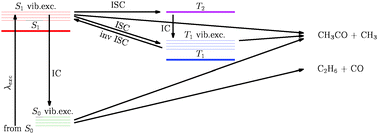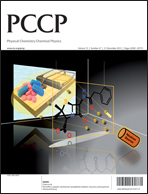Dynamics of acetone photodissociation: a surface hopping study†
Abstract
We present on the fly surface hopping simulations of the dynamics of photoexcited acetone in the n → π* band, taking into account both the spin–orbit and the dynamic couplings and allowing for the C–C bond dissociation. The S0, S1, T1 and T2 states were considered and the propagation time was 50 ps. According to the simulation results, after excitation to S1 both Internal Conversion (IC) to S0 and InterSystem Crossing (ISC) to T1 or T2 take place at comparable rates; T2 plays an important role and the simultaneous treatment of the spin–orbit and dynamic couplings is shown to be mandatory to describe the photodynamics. We propose a mechanism that explains the observed fast and slow decay rates of the S1 state of acetone.


 Please wait while we load your content...
Please wait while we load your content...